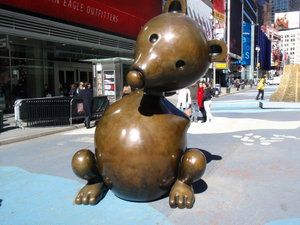Advertisement
Published: December 29th 2011

 Times Square Sculpture
Times Square Sculpture
One of a series of sculptures near Times Square to promote the Armory ShowArmory Show
Today I attended the
Armory Show.
It takes its name from the famous
Armory Show of 1913, which introduced European Modernism to the US for the first time.
This Armory Show attempts to show the best of current contemporary art.
It’s prestigious, and attracts galleries from around the world.
As you would expect for a show in New York, it’s also very expensive, with prices starting in the low four digits and rising from there.
Most of the pieces did not have prices attached, and if one has to ask, it’s a sign to head somewhere else.
I used the show as a concentrated overview of current trends.
The show is very exhaustive and exhausting.
It’s important to know what one likes going in, and be selective about what is viewed in depth.
Otherwise, sensory overload quickly sets in.
Having enough knowledge of art, and art history, to discuss things intelligently with the gallery representatives is also very helpful, although not strictly required.
It took me most of a day to see the entire show.
The best work by top names is sold privately by

 Urban sheep
Urban sheep
A flock of artificial sheep celebrates the Armory Showgalleries, so the show had mostly middling work by top names and top work by mid-career artists.
The work revealed several interesting trends.
There were a number of pieces of neon art, most inspired by the neon word art of the early seventies.
One artist had created a fence of neon, to show the violence of a fence as a divider of space.
There was a large amount of abstract painting, which tried to combine the geometric and expressionist trends of the 1960s.
The effectiveness of this combination varied considerably.
There were a number of pop-art inspired sculptures in the Jeff Koon’s mode.
There was also a large amount of figurative painting of varying degrees of realism, which I am not a big fan of.
There was one group of work by
Gregory Scott that combined video and painting in a really creative way.
The work initially looks like a portrait of the artist in a gallery, looking at multiple paintings.
In reality, those paintings are LED screens imbedded in the work, and the view on those screens changes.
Most of the videos make clever comments on the
art-making process (such as one where the artist appears in the frame and removes the painting!)
Another artist,
David Kramer, had a series of drawings that at first glance appeared to be superhero cartoons.
Read closely, however, and they become critiques of current society (in one, a Superman like character is wondering why he has no health insurance).
One section of the show featured older works that are now part of the modern art cannon.
The highlight for me here was a
gallery showing geometric
Op Art from the 1960s.
All of the artists were from a group in Cleveland which I had never heard of before.
All in all, the show provided what I was looking for.
Times Square
After the show, I headed to Times Square for dinner.
Still promoted as the crossroads of America, this famous intersection is a riot of neon, video screens, and billboards.
It’s the only area in the US where gaudy advertising is actually required by the zoning code.
Unfortunately, it has also been turned into an urban theme park, with full encouragement from the city.
There are

 Times square by night
Times square by night
The former Times building in Times Square by night, a riot of neon and LED billboards. This is one of the most famous night views on earth.branches of suburban mall stores and chain restaurants everywhere.
Nothing symbolizes this trend more that the chocolate war intersection on Broadway, where a
Hershey’s Chocolate Emporium and a
M&Ms World face off, both selling products that most people could just as well buy at their local supermarket.
Embedded within this insanity is a much more authentic experience.
I had dinner at one of them, the
Edison Café.
The Hotel Edison opened in the 1920s and was one of the better hotels in New York.
Since then, it has fallen into a state of faded glamour.
The Café in the hotel is one of New York’s most authentic Jewish Delis, and a favorite of theatre people of all sorts.
The food is good, the prices are low, and the service is fast.
The room is filled with old period detail that hasn’t been updated or renovated in at least fifty years.
It’s the type of place where New Yorkers eat on a daily basis, and as such the most authentic restaurant experience around.
It’s certainly better than the tourist traps elsewhere in this neighborhood.
I loved it.
Advertisement
Tot: 0.095s; Tpl: 0.011s; cc: 12; qc: 24; dbt: 0.0529s; 1; m:domysql w:travelblog (10.17.0.13); sld: 2;
; mem: 1.1mb















